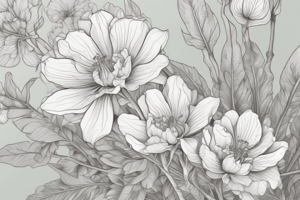Podcast
Questions and Answers
What are the two parts of a typical stamen?
What are the two parts of a typical stamen?
filament and anther
Which structure in the flower is the proximal end of the filament attached to?
Which structure in the flower is the proximal end of the filament attached to?
- Ovary
- Thalamus (correct)
- Petal
- Sepal
What is the typical nature of an angiosperm anther?
What is the typical nature of an angiosperm anther?
bilobed with dithecous theca
What is the function of the tapetum in an anther?
What is the function of the tapetum in an anther?
How do tapetal cells become bi-nucleate?
How do tapetal cells become bi-nucleate?
What happens to the cells of the sporogenous tissue as the anther develops?
What happens to the cells of the sporogenous tissue as the anther develops?
What is the ploidy of the cells in a microspore tetrad?
What is the ploidy of the cells in a microspore tetrad?
What is the shape of a typical microsporangium in a transverse section?
What is the shape of a typical microsporangium in a transverse section?
What is the main purpose of the outer three wall layers of a microsporangium?
What is the main purpose of the outer three wall layers of a microsporangium?
How many microsporangia are present in each lobe of an anther?
How many microsporangia are present in each lobe of an anther?
What is the function of the cells of the tapetum?
What is the function of the cells of the tapetum?
What is the shape of a typical anther?
What is the shape of a typical anther?
What is the total number of microsporangia in an anther?
What is the total number of microsporangia in an anther?
What is the characteristic feature of the cells of the tapetum?
What is the characteristic feature of the cells of the tapetum?
What is the advantage of collecting and arranging stamens from different species on a slide?
What is the advantage of collecting and arranging stamens from different species on a slide?
What runs lengthwise separating the theca in an anther?
What runs lengthwise separating the theca in an anther?
What do the microsporangia develop into?
What do the microsporangia develop into?
Flashcards are hidden until you start studying
Study Notes
Structure of a Stamen
- A stamen consists of two parts: the filament (a long, slender stalk) and the anther (a terminal, generally bilobed structure)
- The filament is attached to the thalamus or petal of the flower at its proximal end
- The number and length of stamens vary in flowers of different species
Anther Structure
- A typical angiosperm anther is bilobed with each lobe having two theca (dithecous)
- A longitudinal groove often runs lengthwise, separating the theca
- The anther is a four-sided (tetragonal) structure consisting of four microsporangia located at the corners, two in each lobe
Microsporangium Structure
- In a transverse section, a microsporangium appears near circular in outline
- It is surrounded by four wall layers: epidermis, endothecium, middle layers, and tapetum
- The outer three wall layers provide protection and aid in anther dehiscence to release pollen
- The tapetum, the innermost wall layer, nourishes developing pollen grains
- Tapetal cells have dense cytoplasm and often have more than one nucleus
Sporogenous Tissue and Microsporogenesis
- The sporogenous tissue occupies the centre of each microsporangium in young anthers
- The cells of the sporogenous tissue undergo meiotic divisions to form microspore tetrads as the anther develops
- The ploidy of cells in the tetrad is haploid
Structure of a Stamen
- A stamen consists of two parts: the filament (a long, slender stalk) and the anther (a terminal, generally bilobed structure)
- The filament is attached to the thalamus or petal of the flower at its proximal end
- The number and length of stamens vary in flowers of different species
Anther Structure
- A typical angiosperm anther is bilobed with each lobe having two theca (dithecous)
- A longitudinal groove often runs lengthwise, separating the theca
- The anther is a four-sided (tetragonal) structure consisting of four microsporangia located at the corners, two in each lobe
Microsporangium Structure
- In a transverse section, a microsporangium appears near circular in outline
- It is surrounded by four wall layers: epidermis, endothecium, middle layers, and tapetum
- The outer three wall layers provide protection and aid in anther dehiscence to release pollen
- The tapetum, the innermost wall layer, nourishes developing pollen grains
- Tapetal cells have dense cytoplasm and often have more than one nucleus
Sporogenous Tissue and Microsporogenesis
- The sporogenous tissue occupies the centre of each microsporangium in young anthers
- The cells of the sporogenous tissue undergo meiotic divisions to form microspore tetrads as the anther develops
- The ploidy of cells in the tetrad is haploid
Studying That Suits You
Use AI to generate personalized quizzes and flashcards to suit your learning preferences.




